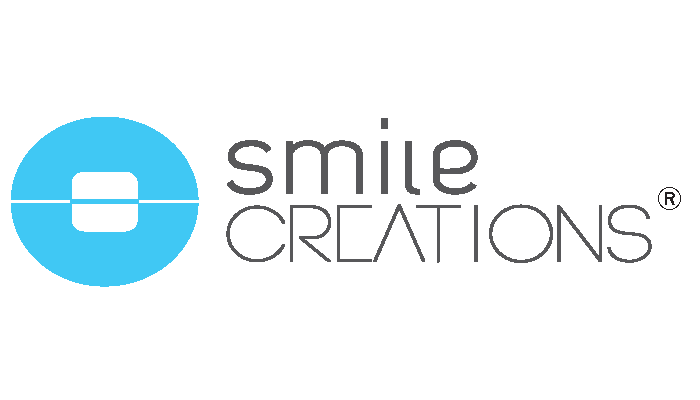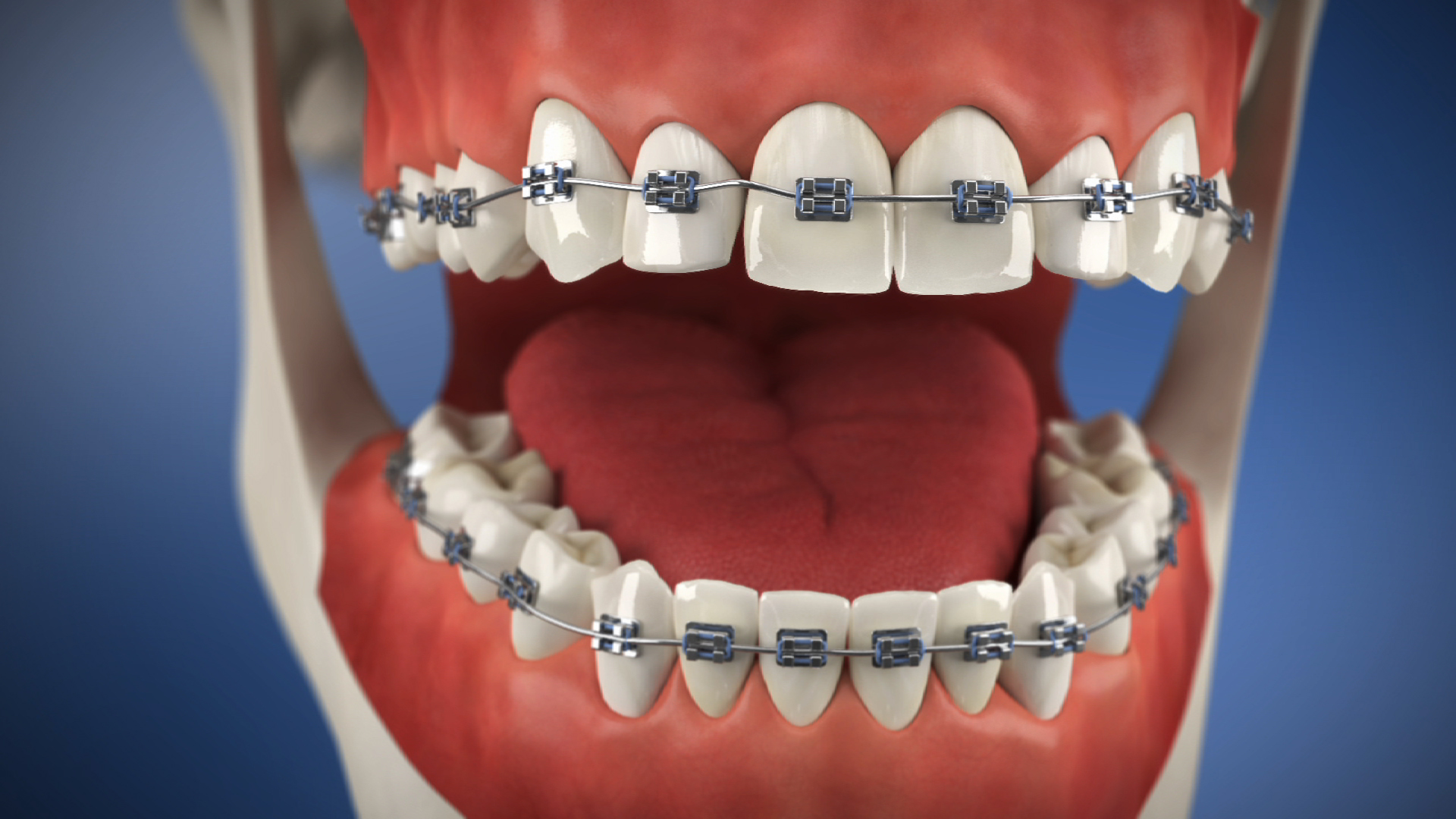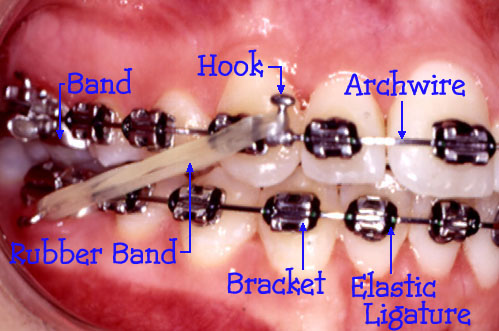
Archwire: This is the main wire that fits into the brackets or other attachments, on the outside of your teeth. It provides most of the forces that move your teeth. The archwire also provides a track along which your teeth move.
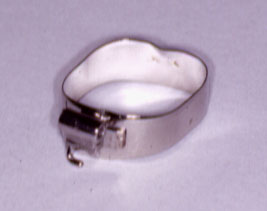 Bands: These are thin bands of metal, carefully fitted to the tooth and then cemented in place. They carry brackets, tubes, hooks, or rotating levers (in other words, they become a handle on your tooth). They give us a way to grasp and control each individual tooth.
Bands: These are thin bands of metal, carefully fitted to the tooth and then cemented in place. They carry brackets, tubes, hooks, or rotating levers (in other words, they become a handle on your tooth). They give us a way to grasp and control each individual tooth.
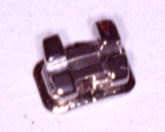 Brackets: Small attachments that are bonded to your teeth. Brackets transmit the forces from the archwire to your teeth.
Brackets: Small attachments that are bonded to your teeth. Brackets transmit the forces from the archwire to your teeth.
Elastic Ligature: These little rings, or colored modules, are used to attach the archwire to the brackets. There are plenty of colors to choose from including clear rings. The modules are dark green in the photo above.
Hooks: Small attachments used to apply forces to the archwire or individual teeth. These are usually used to attach rubber bands.
 Rubber bands: Often called “elastics”, rubber bands are used to provide special forces to your teeth. These forces cannot be achieved with archwires alone and require excellent patient cooperation.
Rubber bands: Often called “elastics”, rubber bands are used to provide special forces to your teeth. These forces cannot be achieved with archwires alone and require excellent patient cooperation.
Other orthodontic terms:
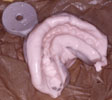 Impressions: We use a soft gelatin-like material, which is placed in a small tray that fits over your teeth. In a manner of a few moments, your teeth leave a print in this material, similar to your handprint in soft sand on the beach.
Impressions: We use a soft gelatin-like material, which is placed in a small tray that fits over your teeth. In a manner of a few moments, your teeth leave a print in this material, similar to your handprint in soft sand on the beach.
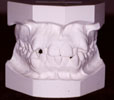 Models: Models are the white plaster records of your teeth which result from making the impression we have just described. We pour the white plaster into your mold, or impression, the plaster sets, and now we have models of your teeth.
Models: Models are the white plaster records of your teeth which result from making the impression we have just described. We pour the white plaster into your mold, or impression, the plaster sets, and now we have models of your teeth.
 Headfilm: This is an x-ray that we take of your head, from the side and sometimes from the front. This allows us to measure the growth of your face. Small plastic rods rest in your ear, on either side, as we take this picture, helping to hold your head in the exact position we need for the x-ray picture.
Headfilm: This is an x-ray that we take of your head, from the side and sometimes from the front. This allows us to measure the growth of your face. Small plastic rods rest in your ear, on either side, as we take this picture, helping to hold your head in the exact position we need for the x-ray picture.
Separators: Many times, it is first necessary to place either small wires or small elastics between your teeth to help make room for the placing of your future braces. This often may feel as if you have a piece of meat caught between your teeth. This sensation passes quickly as your teeth move apart.
Study film: This is merely a headfilm, which we may take from time to time during your treatment, in order to study the progress of your orthodontic care.
Appliances: This is what we call your braces. Your appliances are made up of such things as bands, archwires, brackets, tiewires, hooks and tubes.
Tubes: Usually on the very back teeth, or molars, we will place a long, round, or rectangular tube. The archwire goes into the smaller tube and the headgear arm goes into the larger tube.
Tiewire: These are the funny little fine wires, that fasten your archwire into the brackets. They are twisted, leaving a small “pigtail,” or twisted wire, which is then tucked under the archwire. Sometimes, in eating or brushing, this may become bent out and form a little sticker. If this happens, push it back against the archwire, until we can see you.
 Retainer: Retain means to hold. These are the removable plastic appliances that we often place when your braces are removed. This may be used to close small spaces between your teeth, make minor movements of your teeth, or merely hold your correction once it has been completed.
Retainer: Retain means to hold. These are the removable plastic appliances that we often place when your braces are removed. This may be used to close small spaces between your teeth, make minor movements of your teeth, or merely hold your correction once it has been completed.
Headgear: This is the means by which we use the back of the neck, or top of the head, to pull from the outside to move the teeth inside your mouth. By using these outside forces, we find we can help in changing the way your face grows, as well as moving your teeth in a much easier manner for you.
Bite: This is another name for the way your teeth fit together when you bring them into a normal chewing relation.
Crossbite: Nature intended that all of your teeth fit in an orderly manner. That is, all of the upper teeth fitting slightly on the outside of your lower teeth. When a lower tooth slips to the outside of an upper tooth, this is what we call a crossbite.
Overbite: This is merely a term to describe the upper teeth biting over the lower teeth. Some overbite is normal. Too much overbite can cause severe problems and facial changes that are not particularly good.
